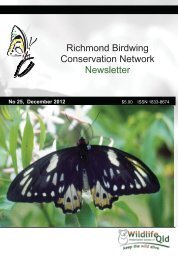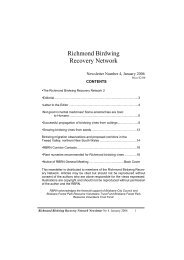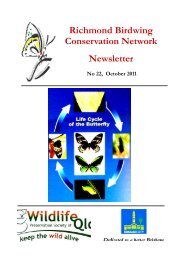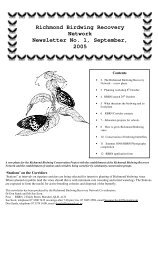Richmond Birdwing Recovery Network Inc.
Richmond Birdwing Recovery Network Inc.
Richmond Birdwing Recovery Network Inc.
You also want an ePaper? Increase the reach of your titles
YUMPU automatically turns print PDFs into web optimized ePapers that Google loves.
PRESIDENT’S REPORT<br />
Don Sands<br />
In the development of recovery plans for insects, certain key criteria are<br />
identified as a basis for threat abatement and the implementation of<br />
recovery actions. Mapping the currently-known and past distribution of an<br />
insect, evidence for any changes in its range and the number of discreet<br />
secure populations (habitats and food plants if a plant-feeder), form part of<br />
the assessment process. Unlike the needs for threatened vertebrates or<br />
plants, counts of individuals, or fluctuations in their numbers are generally<br />
of little value unless the species occupies “closed” habitats (without<br />
connectivity) and has only one generation per year. Counting adults can<br />
be misleading and immature stages may be very hard to detect.<br />
Fluctuations in numbers often vary according to season but not<br />
necessarily from threats. Recording the number of viable breeding<br />
populations on the other hand is more appropriate especially if a species<br />
resides only in fragmented habitats. The tenure and land use can be<br />
applied to consider sustainability of habitats. In the case of the <strong>Richmond</strong><br />
birdwing, in-breeding depression leading to extinctions may result from<br />
habitat fragmentation (loss of connectivity between populations), as well<br />
as habitat disturbance and destruction. In the longer-term the only way to<br />
address this threat (fragmentation) is by linking healthy populations to<br />
encouragement movement between them, in order to prevent<br />
“bottlenecking” and detrimental genes expressing following in-breeding.<br />
In this Newsletter we report on the first major recovery actions for the<br />
<strong>Richmond</strong> birdwing; the data base and accompanying maps and the<br />
results of the first feasibility study on in-breeding depression. Our mapping<br />
scheme and data base are accessible to any person with the internet.<br />
Developed by RBRN Vice President, Hugh Krenske, the data base also<br />
benefited from major on-going inputs from Pam and Ray Seddon. Thanks<br />
to South East Queensland Catchments for guidance, products and the<br />
printed copies. Hugh has worked tirelessly to produce this system,<br />
possibly unique, to be used by anyone observing birdwings and wishing to<br />
record food plant locations and distribution. The maps can: (i) demonstrate<br />
past, current and annual changes in distribution of the butterfly stages and<br />
food plant vines, (ii) be overlayed to determine associations with tenure of<br />
habitats, (iii) provide identification of corridors, Stations or Links; show<br />
connectivity between populations and (iv) can be up-dated with data as it<br />
becomes available.<br />
<strong>Richmond</strong> <strong>Birdwing</strong> <strong>Recovery</strong> <strong>Network</strong> Newsletter No.11 April 2008 2








